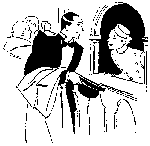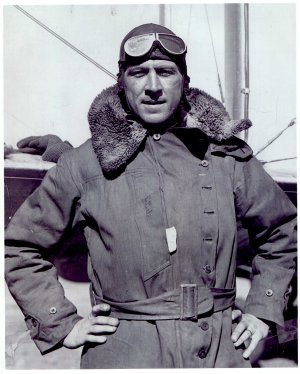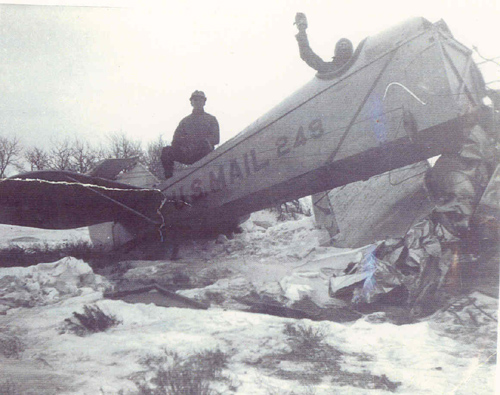
|
|
OLD 249 – THE MOVIE
|
This is a day that ducks stay grounded, but U.S. Air Mail Service pilots rate no such luxury. Clouds hang low and the wind swirls dry snow into the air like desert dust devils. Boonstra flies low at 200 feet under a thick layer of clouds. Now and then he peers over the side of his DH to view the rugged landscape below. Suddenly, over Porcupine Ridge, southeast of Coalville, Utah, a gust of wind, whips against the side of his plane. Caught by surprise, Boonstra has no time to turn, slow his speed or even cut the switches. Helpless, he holds tight while the DH skids on its belly to a stop on the ridge. Surprised to find himself bruised but alive, Boonstra clambers out of the cockpit and looks around. He assesses his prospects -- he has landed on a remote mountain ridge 9,400 feet high, far from signs of human life -- his prospects don�t look promising. He tucks his compass in his pocket, grabs his traveling bag and slogs through the snow, sometimes waist-deep. All day he trudges on. Light fades as night approaches, but still he stumbles down the slope through the woods. The temperature dips below freezing, and when he rests, his feet turn numb. Dawn arrives and with it a raging blizzard. Boonstra, still on the move, spots the first sign of human habitation -- a barn about three miles ahead of him. He pitches ahead, eventually reaching the building. There, he is discovered and given shelter and nourishment. He rests for two days as a guest of the farmer. In the meantime, the Post Office Department conducts an extensive ground and air search for their missing pilot. Finally able to ride a horse, Boonstra travels three miles to the nearest phone and relays his position to Salt Lake City. A few days later he’s back in the air flying the Salt Lake City – Rock Springs route. TIME PASSES The story should end with the pilot safe and the plane an unretrievable hulk sitting on a remote ledge. But it doesn�t.
More than 40 years go by. A new hero enters the picture. His name is J. W. (Bill) Hackbarth, and he�s an aging but still vital U.S. Post Office Service mechanic played by a Spencer Tracy look-alike. Hackbarth�s dream is to find and rebuild an old de Havilliand 4 in time for the golden anniversary of the inauguration of the airmail service. It doesn�t take him long to decide on old 249 now laying in three feet of grass and snow atop Porcupine Ridge, virtually undisturbed since Boonstra left it all those years before. Most other airmail planes had long since been destroyed, burned or scraped.
Hackbarth convinces a back-country sheep man to retrieve the 600 remaining parts of the plane and haul them down the mountain. Once the bits and pieces are salvaged, the Air Mail Pioneers, under Hackbarth�s direction, set about putting them together. Then, as in any good movie, a near catastrophe brings the plot to a dramatic climax. In mid-October 1967, the raging flames of the South Mountain Fire consumed Hackbarth�s ranch in Santa Paula, California, and lay waste to old 249, now within a month of completion. "The fire was so hot," Mrs. Hackbarth told The Ventura County (Calif.) Star-Free Press, "that it completely melted an engine. The handle of a cast iron frying pan is also completely melted." What to do? According to former Strategic Air Command pilot Jim Collison, a Pennsylvania widow came to the rescue. Collison writes: In May, 1990 was hung 60 years visual history of Burbank (CA) Airport. It is laid out by decades beginning with the �20s through the �90s. The lead photograph is of Bill Hackbarth's marvelous smiling face (�68) as he looks out at you from the cockpit of his DH-4. Two weeks later he left on the cross-country flight eastward. This exhibit area has undergone some interior architectural changes in the last eight years. The photographs and copy are spread along 60' of two opposite walls. It is worth hesitating a moment to look, read story/captions and reflect. Amelia is there--the war years--and more. You may recall, a grass fire, which burned the DH-4. Bill was almost broken in spirit even as he repaired the damage, but with long silences, his wife told me. Where was he to find a Liberty engine? What recourse? Where to go--and what to do? Were there any left in Hollywood? In the 20s the silent era movie studios began using Liberty engines as wind machines for westerns and other outdoor films. Too late, these big-bladed aircraft engines were long gone. Then it happened. A sweetest of calls to the Hackbarths in Santa Paula, CA, home of old 249. A long retired and widowed Pennsylvania farm lady said, "My husband kept a new Liberty engine in the barn... and it's never been used..still in its original wrappings...full of grease these many years..and it is yours for nothing if you will pay the transportation out there." And you know the rest of the story. And so the widow and the Liberty engine resurrected the dream; and the Air Mail Pioneers hurried to rebuild what they�d lost. They tucked some of the wreckage into the replica and on May 9, 1968, as scheduled, Hackbarth arrived in Washington D.C. after winging his way across the continent in old 249 along the old transcontinental route. Our movie closes on an upbeat note as Air Mail Pioneers gaze proudly on the rebuilt de Havilland; the music swells. Postscript
from Collison: Sadly, Bill became ill at the start of his 50-year Air Mail
anniversary, west-to-east flight routing in the restored DH-4. While
eating breakfast at the Santa Paula airport cafe, his wife and I discussed his
respiratory challenge and the endurance required for the open-cockpit demands in
wind and cold. |
History |
Air Mail Pilots
|
Photo
Gallery |
Flight Info
|
Antique Airplanes
|
Members |
|
copyright © 1999 Nancy Allison Wright, President Air Mail Pioneers
|
 The saga of old #249 would make a great plot for an action-packed adventure movie.
Picture, if you will, Paul Newman playing the daring young airmail pilot Henry
G. Boonstra. The scene opens with Boonstra lifting off from Salt Lake City
airfield in his de Havilland 4 bound for Rock Springs, Wyoming. The date is
December 15, 1922; the time, 7:30 a.m.
The saga of old #249 would make a great plot for an action-packed adventure movie.
Picture, if you will, Paul Newman playing the daring young airmail pilot Henry
G. Boonstra. The scene opens with Boonstra lifting off from Salt Lake City
airfield in his de Havilland 4 bound for Rock Springs, Wyoming. The date is
December 15, 1922; the time, 7:30 a.m.

